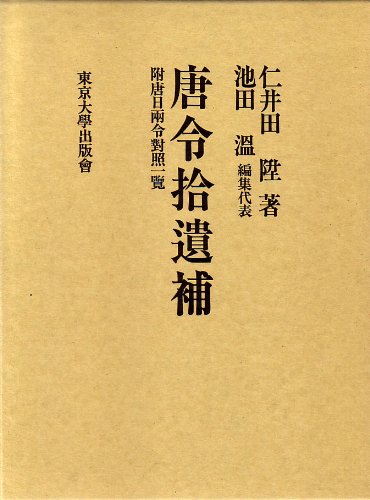2 0 0 0 OA 唐朝氏族志の一考察 : いわゆる敦煌名族志残巻をめぐって
- 著者
- 池田 温
- 出版者
- 北海道大學文學部
- 雑誌
- 北海道大學文學部紀要 (ISSN:04376668)
- 巻号頁・発行日
- vol.13, no.2, pp.1-64, 1965-03-27
2 0 0 0 IR 唐代の郡望表(上):九・十世紀の敦煌写本を中心として
- 著者
- 池田温
- 雑誌
- 東洋学報 / The Toyo Gakuho
- 巻号頁・発行日
- vol.42, no.3, pp.293-331, 1960-06
In recent years, some works of Prof. N. Niida (仁井田陞) and Prof. W. Eberhard have added considerably to the study of the caste system (身分制度) of old China. Their studies of intra-caste marriage (Ebenbürtigkite) in hundreds noble families between the period of the Six Dynasties and the beginning of the T'ang Dynasty especially valuable in the study of the caste system of China, notwithstanding the former regards it as ancient aristocracy, the latter regards it as medieval gentry. The basic data for research on this question is the lists of county nobles found at Tun-huang. However, the qualification of this document as data has been in doubt, with Hsiang Ta (向達) and K. Utsunomiya (字都宮清吉) etc. taking the viewpoint that it is the Chên-kuan-Shih-tsu-chih compiled at the order of the Emperor T'ai-tsung and with Mou Jun-sun (牟潤孫) taking the viewpoint that it was forged by poverty-stricken member of famous nobles with the intention of raising the marriage price.After an inclusive study of materials concerning to this subject the author reached the following conclusions: 1) The following items discovered at Tun-huang are tables of county nobles which may be called Chün-wang-piao 郡望表 (lists of county nobles) and have no connection with the Chên-kuan-Shih-tsu-chih (貞観氏族志). A) 位字79號 (incomplete roll copied by a bhiksu Wu-chên in 836 A. D.). B) S.5861 (4 fragments) & P.3191 (incomplete). C) S. 2052. D) P.3421 (incomplete). 2) The records of distinguished family-names in many counties contained in the T'ai-p'ing-huan-yü-chi (太平寰宇記), Kuang-yün (廣韻) and Ku-chin-hsing-shih-shu-pien-chêng (古今姓氏書辯證), are also reckoned to have their sources in the lists of same category. 3) On careful comparison with the descriptions of several Sung (宋) bibliographies, we may identify A with the Chou-shih-tsu-p'u (諸氏族譜), and B and the list in T'ai-p'ing-huan-yü-chi with the T'ien-hsia-chün-wang-shih-tsu-p'u (天下郡望氏族譜). 4) These lists of county nobles have neither official nor authentic character, but are the products of popularity, and differentiating into some variations they spread over to wide people. 5) The intra-caste marriage system found in these lists has some reflection of the real circumstances in the former period, but on the other hand we can not deny it include the element of fiction. 6) The origin of these lists perhaps had any connection with the Clan-adjustment policy of Emperor Hsiao-wen of Northern Wei dynasty, and afterwards their diffusion has been continued in the decline period of nobilities.
2 0 0 0 OA <宮崎市定博士追悼録>追悼記事
- 著者
- 荒木 敏一 伊藤 道治 池田 温 池田 誠 稻葉 一郎 岩見 宏 上田 早苗 植松 正 梅原 郁 江幡 眞一郎 小田 壽典 小谷 仲男 小野 信爾 愛宕 松男 織田 武雄 大島 利一 大谷 敏夫 狩野 直禎 勝藤 猛 河内 良弘 河地 重蔵 神戸 輝夫 衣川 強 楠山 修作 小玉 新次郎 近藤 治 佐伯 富 佐竹 靖彦 佐藤 圭四郎 佐藤 長 佐藤 陸雄 重松 伸司 島居 一康 島田 虔次 菅野 正 杉村 邦彦 田中 整治 田村 實造 谷 光隆 谷川 道雄 谷口 規矩雄 竺沙 雅章 寺田 隆信 寺廣 映雄 礪波 護 中谷 英雄 永田 英正 西里 喜行 波多野 善大 萩原 淳平 日比野 丈夫 藤枝 晃 藤本 勝次 藤善 眞澄 藤原 利一郎 堀田 伊八郎 間野 英二 宮川 尚志 村上 嘉實 森 正夫 森本 公誠 柳田 節子 横山 裕男 吉川 忠夫 若松 寛
- 出版者
- 東洋史研究會
- 雑誌
- 東洋史研究 (ISSN:03869059)
- 巻号頁・発行日
- vol.54, no.4, pp.5-74, 1996-03-31
1 0 0 0 唐令拾遺補 : 附唐日兩令對照一覽
- 著者
- 池田 温
- 出版者
- 東方書店
- 雑誌
- 東方 (ISSN:09108904)
- 巻号頁・発行日
- no.228, pp.22-25, 2000-02
- 著者
- 池田 温
- 出版者
- 公益財団法人 史学会
- 雑誌
- 史学雑誌 (ISSN:00182478)
- 巻号頁・発行日
- vol.91, no.9, pp.1478-1479, 1982-09-20 (Released:2017-11-29)
1 0 0 0 書評・新刊紹介 平岡武夫著『白居易--生涯と歳時記』
- 著者
- 池田 温
- 出版者
- 唐代史研究会
- 雑誌
- 唐代史研究 (ISSN:13443100)
- 巻号頁・発行日
- no.3, pp.110-117, 2000-06
1 0 0 0 明治期に中国へ流出した日本寺院旧蔵文書に関する総合的研究
本調査研究によって解明された主要な点を上げるならば、次のとおりである。1.明治維新後の日本において、中国人蒐書家によって系統的な典籍の蒐集がなされ、中国本土に移送されていた。ことに清国総領事黎庶昌や清国領事館駐在員であった楊守敬らによって系統的に蒐集されて、中国大陸に移送され、その後、各地を転々とするとともに、日中戦争から国共内線の時期における散逸、焼亡の危機をくぐりぬけて今日に伝来するにいたった各種図書・文献について、その所在を跡づけることができた。2.京都高山寺の寺院文書が、中国武漢の湖北省博物館において所蔵されていることをつきとめた。今回の発見成果の重要なものの一つが、この湖北省博物館所蔵の高山寺文書であった。これも楊守敬蒐集図書の一部をなしている。明治初年の日本社会では廃仏毀釈の嵐が吹き荒れており、寺院の什器や経巻の類が流出して古物市場にあふれていた。高山寺文書の流出も多岐にわたっているが、その一部が楊守敬の購入するところとなり、中国に伝存することとなったのである。3.今回の調査で、日本の仏典が中国各地の所蔵機関に少なからず伝存することを確認し得た。そして同時に次の点が問題であることが判明した。すなわちこれら日本から請来された仏書、写経の類は、中国人の目からは敦煌伝来の仏典と見なされる傾向があるという点である。明白に日本で書写された経巻であるにもかかわらず、それらがしばしば敦煌伝来の写経と混同して所蔵され、また目録上にもそのような配列記載がなされているという問題である。これは日本人研究者の考えの及ばなかった問題でもあり、日中双方の研究者・関係者の協議に基づいて、問題が早急に改善されることが望まれる。
- 著者
- 宮西 照夫 池田 温子 畑山 悦子
- 出版者
- [全国大学メンタルヘルス研究会]
- 雑誌
- 全国大学メンタルヘルス研究会報告書 (ISSN:13437046)
- 巻号頁・発行日
- vol.26, pp.132-134, 2004
- 著者
- 宮西 照夫 池田 温子 畑山 悦子
- 出版者
- [全国大学メンタルヘルス研究会]
- 雑誌
- 全国大学メンタルヘルス研究会報告書 (ISSN:13437046)
- 巻号頁・発行日
- vol.27, pp.19-22, 2005
- 著者
- 池田 温
- 出版者
- 創価大学
- 雑誌
- 創価大学人文論集 (ISSN:09153365)
- 巻号頁・発行日
- vol.19, pp.69-102, 2007-03
1 0 0 0 OA 唐令と日本令(一)
- 著者
- 池田 温
- 出版者
- 創価大学
- 雑誌
- 創価大学人文論集 (ISSN:09153365)
- 巻号頁・発行日
- vol.7, pp.144-175, 1995-03



